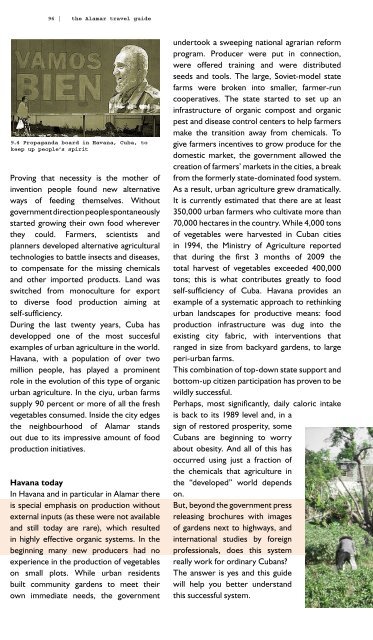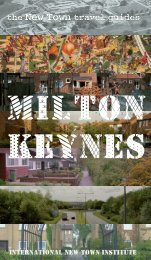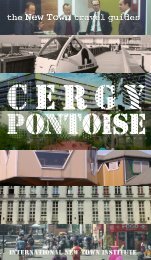Create successful ePaper yourself
Turn your PDF publications into a flip-book with our unique Google optimized e-Paper software.
96 | the <strong>Alamar</strong> travel guide<br />
9.4 Propaganda board in Havana, Cuba, to<br />
keep up people’s spirit<br />
Proving that necessity is the mother of<br />
invention people found new alternative<br />
ways of feeding themselves. Without<br />
government direction people spontaneously<br />
started growing their own food wherever<br />
they could. Farmers, scientists and<br />
planners developed alternative agricultural<br />
technologies to battle insects and diseases,<br />
to compensate for the missing chemicals<br />
and other imported products. Land was<br />
switched from monoculture for export<br />
to diverse food production aiming at<br />
self-sufficiency.<br />
During the last twenty years, Cuba has<br />
developped one of the most succesful<br />
examples of urban agriculture in the world.<br />
Havana, with a population of over two<br />
million people, has played a prominent<br />
role in the evolution of this type of organic<br />
urban agriculture. In the ciyu, urban farms<br />
supply 90 percent or more of all the fresh<br />
vegetables consumed. Inside the city edges<br />
the neighbourhood of <strong>Alamar</strong> stands<br />
out due to its impressive amount of food<br />
production initiatives.<br />
Havana today<br />
In Havana and in particular in <strong>Alamar</strong> there<br />
is special emphasis on production without<br />
external inputs (as these were not available<br />
and still today are rare), which resulted<br />
in highly effective organic systems. In the<br />
beginning many new producers had no<br />
experience in the production of vegetables<br />
on small plots. While urban residents<br />
built community gardens to meet their<br />
own immediate needs, the government<br />
undertook a sweeping national agrarian reform<br />
program. Producer were put in connection,<br />
were offered training and were distributed<br />
seeds and tools. The large, Soviet-model state<br />
farms were broken into smaller, farmer-run<br />
cooperatives. The state started to set up an<br />
infrastructure of organic compost and organic<br />
pest and disease control centers to help farmers<br />
make the transition away from chemicals. To<br />
give farmers incentives to grow produce for the<br />
domestic market, the government allowed the<br />
creation of farmers’ markets in the cities, a break<br />
from the formerly state-dominated food system.<br />
As a result, urban agriculture grew dramatically.<br />
It is currently estimated that there are at least<br />
350,000 urban farmers who cultivate more than<br />
70,000 hectares in the country. While 4,000 tons<br />
of vegetables were harvested in Cuban cities<br />
in 1994, the Ministry of Agriculture reported<br />
that during the first 3 months of 2009 the<br />
total harvest of vegetables exceeded 400,000<br />
tons; this is what contributes greatly to food<br />
self-sufficiency of Cuba. Havana provides an<br />
example of a systematic approach to rethinking<br />
urban landscapes for productive means: food<br />
production infrastructure was dug into the<br />
existing city fabric, with interventions that<br />
ranged in size from backyard gardens, to large<br />
peri-urban farms.<br />
This combination of top-down state support and<br />
bottom-up citizen participation has proven to be<br />
wildly successful.<br />
Perhaps, most significantly, daily caloric intake<br />
is back to its 1989 level and, in a<br />
sign of restored prosperity, some<br />
Cubans are beginning to worry<br />
about obesity. And all of this has<br />
occurred using just a fraction of<br />
the chemicals that agriculture in<br />
the “developed” world depends<br />
on.<br />
But, beyond the government press<br />
releasing brochures with images<br />
of gardens next to highways, and<br />
international studies by foreign<br />
professionals, does this system<br />
really work for ordinary Cubans?<br />
The answer is yes and this guide<br />
will help you better understand<br />
this successful system.




